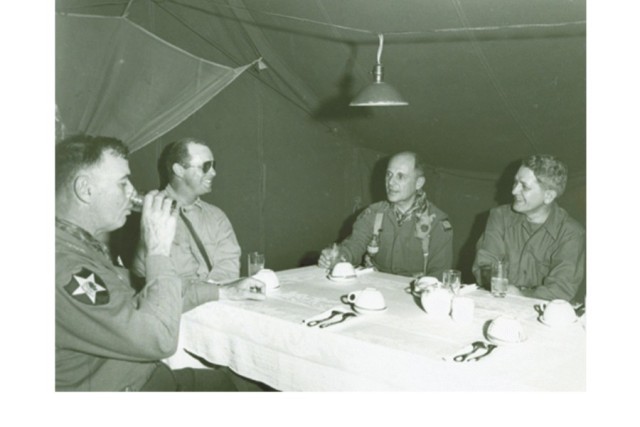What makes a great leader' General Matthew Bunker Ridgway believed the chief ingredients of leadership included character, courage and commitment. Two of his superior officers, themselves among the most effective Army leaders, considered that Ridgway himself demonstrated exemplary leadership.
General Omar N. Bradley, first Chairman of the Joint Chiefs of Staff, declared that "Ridgway's performance in Korea was 'the greatest feat of personal leadership in the history of the Army.'"
General George C. Marshall, Army Chief of Staff during World War II, stated that "General Ridgway has firmly established himself in history as a great battle leader. The advance of his Army Corps to the Baltic in the last phase of the war in Europe was sensational to those fully informed of the rapidly moving events of that day."
General Ridgway himself became Army Chief of Staff on August 15, 1953. Few positions within the Army require such a high level of leadership abilities. This promotion was the culmination of a long and distinguished career that included acts of heroism and leadership that continue to serve as an example for all soldiers.
It was Ridgway who was chosen to lead the transition of the 82nd Infantry Division (the "All Americans") to the 82nd Airborne Division early in World War II. Ridgway was tasked to transform this division into the Army's first airborne division. He invited Sergeant Alvin C. York, World War I hero with the "All Americans," to serve as a mentor to his soldiers. Ridgway used York's experience to provide lessons on soldiering learned on the battlefield, lessons that would mean life or death in the Mediterranean and European Theaters of Operations.
It was Ridgway who was asked to prepare his men for the most significant battle of the 20th century. A modern-day Ulysses, Ridgway jumped into Army lore and parachuted into Normandy with his division in June, 1944. That is one way to define leadership, like Ulysses, leading from the front, with his hand grenade strapped to his uniform. Ridgway later remarked on wearing his trademark hand grenade, "some people thought I wore the grenades as a gesture of showmanship. This was not correct. They were purely utilitarian. Many a time, in Europe and in Korea, men in tight spots blasted their way out with grenades".
The following year, Ridgway built a "bridgehead across the Baltic" preventing the Russians from taking Denmark. Then, in 1950-1951, it was Ridgway who revitalized fighting spirit and combat capabilities of the Eighth Army during the Korean War. In April of 1951, he received an official radio message that President Truman had relieved General Douglas MacArthur and that Ridgway was to take MacArthur's place as Supreme Commander for Allied Powers in the Korean War. His leadership held the troops together and drastically altered the course of that war.
He retired as Army chief of Staff in 1955 but remained active over the ensuing decades. In 1984, during a presentation at the Army War College, Ridgway pronounced "The American Soldier, God he is great, he'll follow leadership if it is there, through hell and high water, and ask no questions, all he wants is leadership". He spent his life leading these men into battles and through wars, and he redefined our interpretation of an Army Leader.
General Matthew Bunker Ridgway died on July 26, 1993, and is buried at Arlington National Cemetery, Arlington, Virginia.
On September 24, 2004, the Army Heritage and Education Center (AHEC) recognized General Ridgway's greatness as a leader by naming the first building of the AHEC complex in his honor. On the plaque honoring his service is written, "Ridgway was a great scholar as well as a great leader, and he understood the importance of studying the lessons of the past". As an innovative leader, Ridgway used Sgt. York's experience to bridge together two generations of heroes, and his instructions may have saved lives. AHEC preserves these stories of valor and greatness. These stories are at the disposal of today's soldier. These stories also allow all Americans to learn and understand the unique story of the American soldier, of leaders like Ridgway, of men and women who have served this great nation in the United States Army. No wonder that the General's name graces the building dedicated to preserving Army history - Ridgway.






Social Sharing